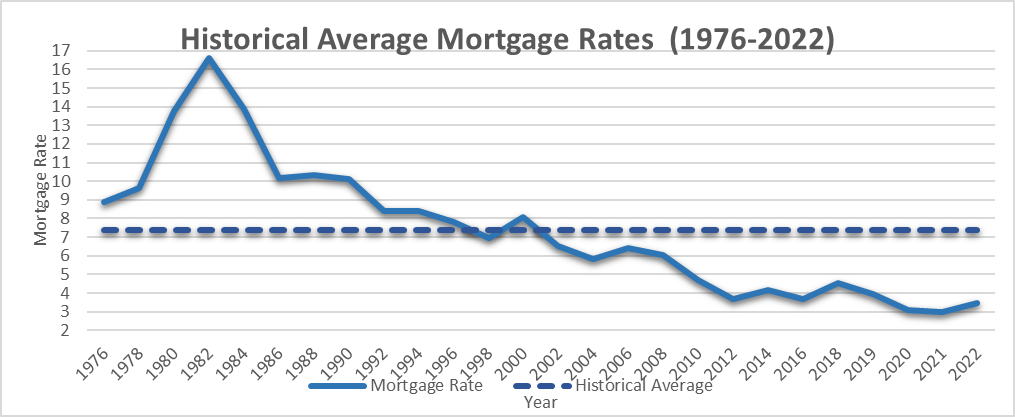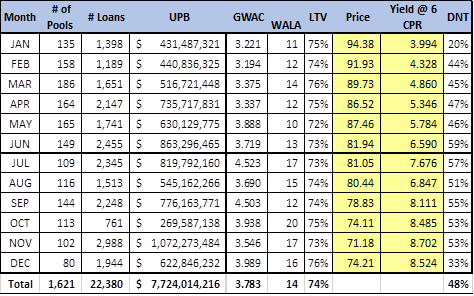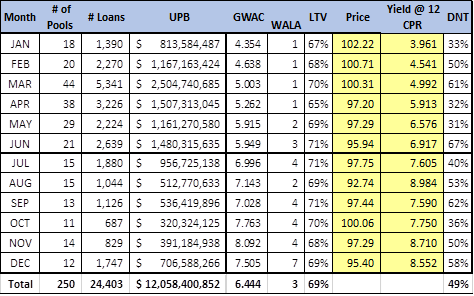Here’s to the end of a difficult and challenging 2022. December 31st may be just a date on the calendar, but Jan 1st is that magical day where we all get to reset our P&Ls to zero. They say a person can drown in a lake with an average depth of 2 feet. We think about this saying when we review 2022 and average it with the previous 3 years.
Before we discuss specific sectors, we thought we’d start with a look back at historical mortgage rates to illustrate what an unprecedented 3 -year period (2019 – 2021) was of exceptionally low rates and easy money. Below is a graph of the average mortgage rate going back to 1976. The average mortgage rate over the past forty odd years has been 7.38%, 4.53% over 20 years and 3.365% the last three years.

2022 marked the first extended period of rising rates and waning liquidity that many market participants have ever experienced.
The Federal Reserve hiked rates seven times in 2022: 25bps in March. 50bps in May. 75bps in June, July, September, and November, and 50bps in December. The Fed has done what it said it would do all along, they also said they aren’t done raising rates and would not be easing in 2023.
Liquidity has been limited as investors finished out the year and closed the books for 2022. There has been an exodus of bank deposits into higher yielding fixed income assets, and a flight to quality and higher yields available in shorter term treasuries with current yields of >5% and >4%, on 1yr and 2yr T-bills, respectively. Investable dollars were constrained in Q4 of 2022 as prepayments slowed. These projected dollars have not yet returned back into the investment market. Moreover, we have reorganizations taking place at some of Wall Street’s largest investment banks and major mortgage players. The MBA has forecasted origination volume will decline to between $1.5 to $2 trillion after having been more than $4 trillion in each of 2020 and 2021 and just under $2.5 trillion in 2022. The treasury is no longer buying new issue MBS, (they were buying~40% of all TBA mortgages issued), but this hasn’t hit market spreads due to low prepays. Primary mortgage spreads over the past 10 years, have averaged ~75 to 80 bps, with the current spread near 200-bps. This means if the yields on the 10-year Treasury note remain in and around 4%, and spreads revert towards the 10-year average, then mortgage rates should drop into the 5% range.
We see this as a buyer’s market with the highest yields we’ve seen in years. There continues to be a battle for the cheapest assets as investors are comparing yields across alternative asset classes. Conversely, new production with high coupons struggle to obtain premiums given a potential market rally in 2023, which could lead to high prepayments and the vaporizing of premium prices paid on these newer higher coupons.
SCRATCH & DENT “S&D”
2022 was another record year for agency and aggregator putbacks as loans with some sort of defect rendered the loans undeliverable. RAMS bid 1,621 pools with 22,380 loans for $7,724,014,216 in 2022.
Originators, who decided not to sell their S&D loans last year due to pricing in the 60’s for loans with interest rates between 2% and 4%, expect pricing to go up as if the New Year included a magical “switch” where interest rates would stabilize and start to decline in short order resulting in higher loan prices. There is usually a pickup in pricing in Q1 as buyers have fresh budgets and look to buy loans, but we are not going back to 90’s pricing on lower rate loans anytime soon.
As shown on the Table below, pricing on S&D loans in 2022 began in the low to mid 90s, but due to the continued market sell off and coupons in the mid 3s, we saw pricing decline down to the low 70s and even upper 60s on certain pools.

As levered buyers moved to the sidelines, an influx of banks and unlevered buyers entered the market with yields in the high single digits to as high as ~9.5%. We are often asked why prices don’t rise when TBA MBS prices rally. The answer is, since S&D loans aren’t deliverable into the TBA market, yields more closely reflect investment yields in the credit sensitive side of the market correlated to the Private Label Securities market (PLS). These low coupon loans, with very slow prepayment assumptions, create long durations that are unattractive to investors. We aren’t believers in the current prepayment assumptions being used in the market, because life happens – people move for jobs and other reasons, a need for more space, divorce, and old age. If these loans never prepaid, and the borrower made their 360th and final payment, you’d be earning a high single digit return with tremendous potential upside if that borrower pays prior to maturity.
We’ve seen a huge pickup in “Did Not Trade” (DNTs) although the Fed says continued rate hikes are ahead. Nearly half (48%) of these pools did not trade due to sellers’ unwillingness to accept current market price levels and/or hoping for prices to improve in 2023. In years 2019 thru 2021 the number of DNT’s was less than 30%. In 2022, we saw a bifurcation between large and small originators in terms of their respective willingness to sell lower rate S&D loans and absorb the related loss on sale. We saw some very large S&D trades completed late in 2022 by large originators, while small originators held onto more S&D loans than they sold.
Most S&D loans are over a year seasoned and we anticipate another 6 to 10 months of heavy volume before we see this start to taper off. In its most recent filings Fannie had $939mm (as of 9/30/22) in outstanding loan-repurchase requests and Freddie had $1.3BB (as of 12/31/21) with originators stating requests had picked up throughout 2022.
Below is a table showing the price sensitivity of changing yields and prepayment speeds assuming 2.5% and 4.00% mortgage loans

What this shows, is even a 100-bps tightening in required yields by investors only improves price by 3 to 4 points. With the marginal upside and negative carry we encourage originators to let the asset managers try to make sense of these lower coupons.
NON-QM
It was a tough year for Non-QM & DSCR originators as they struggled to keep pace with rapidly rising rates and widening spreads. With liquidity waning and the private label securitization (PLS) market in hibernation, we saw warehouse lenders apply pressure to their clients. With the restructuring of one of the largest lenders, and others announcing they may be stepping away from Non-QM financing, advance rates and dwell times are being re-evaluated and re-marked for both current coupon and out of the money production.
There is a backlog of pools ready for securitization and spreads recently have tightened. OCT/NOV “AAA” spreads widened out to ~ +290. A couple of deals were quickly placed at year end at around +220 after not much activity in new deal flow after Thanksgiving. The first deal of 2023 saw AAAs go subject at +175.
The trend for Non-QM production is down. RAMS bid on 250 pools for $12 billion. Consumer Non-QM is currently sub 8% with DSCRs in the mid to high 8%. ITINs and Foreign National yields are back of those more liquid products by a point or two.
Please see table below for Non-QM and DSCR activity by month:

NPLs & EBOs & RPLs
2022 saw a slowdown in NPLs and EBOs as serious DQs shrunk to 1.2% vs 2.4% in 2021 and G2 TBAs lost nearly fifteen points over the year. RAMS marketed 80 pools with 38,592 loans for $5,497,020,296.
GNMA EBOs
When many GNMA EBO loan buyers think of the term “EBO” or “Early Buy Out,” they envision loans either still in a GNMA Security where the Seller is planning to execute a concurrent buyout / sale transaction, or the GNMA EBOs will be repurchased and held for a very brief period by Seller before the loans are sold. In the last two quarters of 2022 (and beginning of 2023), the largest GNMA EBO trades involved the sale of loans repurchased over a year ago. We will see if this trend continues or if Sellers need to execute GNMA EBO trades to help their delinquency rates get back to compliant levels and/or fund advances.
There is no question the pricing of GNMA EBOs is directly impacted by GNMA II Securities pricing. Since we are performing a GNMA EBO evaluation and “sell or hold” analysis for multiple clients on a quarterly basis, we track GNMA II Securities prices and their corresponding impact on GNMA EBO prices very closely.
The great days of 2021 when GNMA EBOs were sold for par, or over par, plus refund of all advances are gone and may not come back for years if ever again. GNMA EBOs are not a profit generator today. Loss Mitigation is the name of the game now. We are big proponents of having a GNMA EBO strategy, so much so that we provide free GNMA EBO Analysis and will help you plan and execute your strategy. Just send us a tape for review and discussion.
NPLs
Conventional NPL pricing for loans with 2%, 3%, and 4% interest rates in the high 50’s to high 60’s (as a percentage of UPB) range in Q4 2022. NPL Buyers had to account for the possibility of borrowers reperforming and getting “stuck” with a long duration, low coupon, asset. The good news for these NPL Buyers is buying NPLs at these levels provides a relatively low “effective LTV” (calculated as actual LTV * purchase price) even if the actual LTV is around 90%. This gives NPL Buyers a lot of cushion in dealing with continued falling home prices. This also provides NPL Buyers with some runway to workout settlements with borrowers before we get close to any kind of property value issue.
We currently see NPLs trading to unlevered yields in the 9%+/–range and this has been steady through Q4 2022.
Odd lot, or small, pools of government insured loans continue to be a bargain, in our opinion, especially FHA insured and lower ltv VA insured loans. On small pools of government insured loans, the NPL Buyer may be asked to refund recoverable escrow advances, but we have not seen many trades (although there are a small amount) where a Buyer will refund recoverable corporate advances. We do not see Buyers refunding interest advances on these smaller trades, so there is a lot of upside if a Buyer can recover advances.
Q3 and Q4 2022 pricing of residential NPLs were heavily impacted by the “risk” of reperformance. The goal of buying NPLs for several decades prior to this year was to get borrowers to reperform and then sell the reperforming loans, into the PLS market. This is very different today. An NPL pool with a high likelihood of reperformance combined with interest rates of 2% to 3.5% can price in the 60’s as a percentage of UPB with a price in the 40’s as a percentage of property value. We think this may be a good time to rethink the RPL sector. These used to be non-performing borrowers from the last Great Financial Crisis that were brought current through some type of modification, typically lowering the coupon, and extending the maturity. Aren’t these just seasoned loans now?
We are also starting to see, for the first time in a while, property valuation variances of opinion between Seller appraisals or BPOs and Buyer BPOs. There are multiple reasons for the variances, and no two evaluations are the same, but the one issue we see more often than others is the use of bad comps, especially on jumbo properties. Sometimes comps are hard to obtain when pricing a property that is much bigger and nicer than others in the area, so the appraiser uses comps from a very high-end neighborhood to comp a property in an average area. We saw one example where the variance was over $3MM on a $7.5MM property.
Many NPL buyers expect 2023 to be full of opportunities as borrowers deal with higher costs of living and lower home values. For an early warning, one area to keep an eye on, is FHA loans, where >80% of FHA purchase volume is first-time homebuyers. According to 2021 HMDA [Home Mortgage Disclosure Act] data, the median income of FHA borrowers is $65,000 per year, compared to $85,000 for VA and $105,000 for conventional borrowers. Lower income families, having just purchased their first home, tend to have limited savings, and stretched budgets, with little ability to adjust to higher inflation, declining property values, and rising unemployment if there is a recession later this year.
We will address Bridge, Fix & Flip, Jumbo, and Specialty Loan Programs in our next update. These segments of the market faced their own unique challenges in 2022.
We like to end our updates with something positive in spite of 2022. We could have gone with the old standby from President Franklin D. Roosevelt’s 1933 Inauguration Speech, “You have nothing to fear but fear itself.” Instead, in honor of the upcoming Martin Luther King, Jr. holiday we will finish with his quote, “Only in the darkness can you see the stars.”

